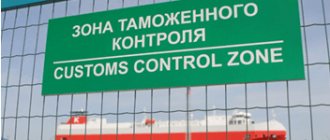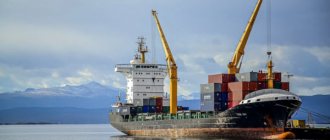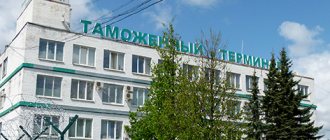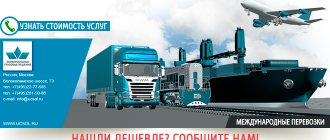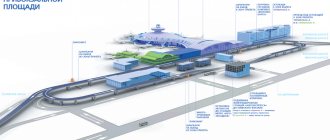First container terminal
CJSC First Container Terminal (PKT) is a system for carrying out various operations at the port and has now become one of the largest terminals handling heavy weight containers. It occupies an absolute leading position on the Baltic Sea. Possessing freeship connections, the First Container Terminal has constant connections with large ports in European ports, including Rotterdam, Hamburg, Bremerhaven, Antwerp. Recently, the St. Petersburg first container terminal was equipped with a refrigeration system, which is one of the largest in Europe. All operations in the system are carried out using the latest technologies: IT, satellite monitoring of cargo containers, electronic document management.
To push into Ust-Luga only with your feet. The port of St. Petersburg is being tried on Primorsk
The idea of moving the Big Port of St. Petersburg zigzagged towards Vyborg. There's more space there.
At the St. Petersburg Economic Forum on June 3, Governor of the Leningrad Region Alexander Drozdenko commented on the possibility of moving the Big Port of St. Petersburg to the Leningrad Region and compared the two locations under discussion - Ust-Luga and Primorsk.
— Primorsk is a new, growing site. There are, of course, much more reserves there than at the site in Ust-Luga for the transfer of the St. Petersburg port. But let us still understand that this is a very complex question. A question of both economics and politics. I think that for now we are at the stage of a feasibility study and collection of indicators. This is not even a preliminary project yet,” the speaker noted.
Video: telegram channel of the government of the Leningrad region
Seaport “Big Port of St. Petersburg” is one of the largest ports in the North-West. Located in the Neva Bay of the Gulf of Finland and the mouth of the Neva. The water area is 164.6 square kilometers, the length of the berth line is 31 kilometers. According to the port, cargo turnover for 2021 amounted to 59.8 million tons of cargo. The port area is almost 600 hectares.
The idea of moving the port outside the city has been discussed for many years. In 2010, there was an outbreak - at that time the general director of Rosmorport, Igor Rusu, publicly spoke in favor of the transfer. But the idea did not meet with the support of either St. Petersburg or the federals.
A fresh impulse arrived at the end of March - co-owner of Transmashholding Andrei Bokarev sent a letter to Vladimir Putin with a proposal to move the facilities of the port of St. Petersburg to Ust-Luga. The President instructed to work on the idea. The transfer project is estimated at 440 billion rubles. On the released hectares, 4.8 million square meters of housing can be built. Examples include Hamburg, Rotterdam, London, Toronto and Yokohama.
A good example is Helsinki, where in 10 years part of the port was moved outside the city. 600 million euros were spent on the liberation of 220 hectares. The territories were built up with expensive, even by Helsinki standards, housing with an area of 2.2 million square meters. m. The new port occupied an area half as large as the old one.
Market participants surveyed are inclined to believe that moving the Big Port's facilities to Primorsk is more preferable. The main reason is simple - there are practically no suitable sites left there - there are already more than enough implemented and announced projects.
Thus, in the port of Ust-Luga there are "Rosterminalugol", the timber terminal "Factor", the multi-profile transshipment complex "Yug-2", "Universal transshipment complex", a road-railway ferry complex, the universal terminal Lugaport, the "Ust-Luga Container Terminal" are being built ", "Novatek Ust-Luga", "Ust-Luga Oil", "European Sulfur Terminal". Builds its own terminal “Ultramar”. There are already a dozen big players in total. In addition, Gazprom and others have announced mega-plants for gas liquefaction and processing, as well as methanol production.
It is clear that it is already difficult to get on this tram. As one of the officials in the government of the Leningrad region emotionally expressed, “Will you show me how to do this physically? You can only push it in with your feet.” Of the land plots that remain, in some places there is no way to build a railway line, in some places there are military lands or forest reserves. In addition to the tightness, it is also important that there is more depth in Primorsk. It is also relatively spacious and has the potential to handle a large amount of cargo.
Among the major projects, the “Universal Loading Complex” by Ilya Traber is being implemented. The president has already drawn attention to it, having at the end of May instructed the chairman of the state development corporation VEB.RF, Igor Shuvalov, to consider the possibility of financing this project. The cost of the complex is estimated at 275 billion rubles. Nearby is the land of the ex-president of Rosneft and owner Eduard Khudainatov . We are talking about the promising Vysokinsky site.
In addition to the technical side, there is also a social one. Considering what kind of human resources will be needed to implement the projects announced in Ust-Luga, one can imagine what questions this will raise among the local population - an influx of migrants is inevitable. On June 3, at SPIEF, fears of the area turning into a ghetto were already voiced. In addition, it so happened that when receiving the plots, no one thought about, so to speak, a master plan. It turned out like in the conventional Murino - they built houses, but didn’t think about schools and roads. As a result, the settlements were too close to industrial areas - hence the complaints about coal dust and constant noise, such as in Vistino.
Let us note that the very idea of a transfer may clash with the disparate opinions of land tenants in the Big Port. One can predict an analogy with Apraksin Dvor, where hundreds of small private owners broke the will of the city authorities to put the territory in order. However, the land in the port is mostly state-owned, leased for 49 years. And if there is a choice - to move out by directive or to move with the opportunity to implement development projects on the vacant plots, then the choice will be simple.
Another thing is that the decision to transfer can only be made by one person. In this regard, it can be assumed that a subtle game of remarks in the public space to attract attention begins.
Victor Smirnov, 47news
Terminal equipment
Currently, the First Container Terminal (FCT) is equipped with the most modern types of equipment. The bulk of it consists of cranes with different lifting capacities, which allows you to work with loads of a wide variety of weights, including oversized ones. On average, the weight of cargo can be up to 50-100 tons. The terminal also has its own developed infrastructure and a large number of container loaders. Its refrigerated section ranks third among European countries and fifth in the world in terms of its equipment.
The company itself invested 2.5 billion rubles in the development of its facilities. just in the last three years. Another 500 million - from the beginning of 2021.
On the issue of port redevelopment, Sea Port of St. Petersburg JSC still considers it necessary to conduct an additional analysis of the project, which would take into account additional costs for the creation of duplicate port infrastructure, including government costs for creating infrastructure to support the activities of state control bodies and the organization of relevant jobs, assessing the cost of relocating facilities and reclamation of vacated lands. The project, according to port workers, should reflect the interests of stevedoring companies that have invested in infrastructure development, and thousands of port specialists and enterprises from near-port industries that may lose their jobs.
Small market participants also say that there is no point in withdrawing the port from the city. “The potential of the port today is not only not exhausted, but is also constantly being realized by both new players and long-existing companies developing new areas of activity. The purchase of land plots in the port territory, the construction of new or modernization of existing facilities, and the construction of modern production facilities are underway. Companies are investing money in the purchase of equipment that significantly increases the terminal’s throughput capacity; there is a constant reorientation to new cargo flows,” says Yulia Abrosimova, general director of KCTL JSC (which owns berths adjacent to Severnaya Verf).
Even for her relatively modest enterprise, the amount of money already invested in development amounts to hundreds of millions (about 350 million rubles over the past three years), and their return is expected only in a five-year perspective.
“Enterprises, as well as owners of facilities located on the port territory or adjacent territories, certainly realize that moving the port outside the city limits is a costly and lengthy process. A move of 5–7 years will lead to the fact that the land of the Big Port is not yet ready for redevelopment, and the new port infrastructure in the process of being created in a new location will not be able to operate at full capacity. At the same time, a number of issues will arise that require a quick and expensive solution, such as the loss of thousands of jobs, a significant increase in the transport load on cars and railways in one direction. As for companies operating in the port using their own infrastructure, the cost of objects potentially subject to purchase may, in some cases, be disproportionately less than the costs that these companies will have to undertake for the purpose of new construction of similar infrastructure. Moreover, moving large equipment will also create significant costs for the owner, which will not be compensated by anyone, says Yulia Abrosimova. “Under such conditions, a situation will inevitably arise that is inconvenient either for the city or for business, and therefore today it is hardly possible to talk about support for the relocation of the port from industrial and transport enterprises.”
The largest plot of port land in private ownership is not owned by stevedores, but by PJSC Kirov Plant (approximately 170 hectares). By the way, it is wrong to believe that he is engaged exclusively in production. Firstly, it has a fairly long coastline. At least a kilometer in the port water area itself and even more along the Ekateringofka, at least at the mouth of which ships are quite actively moored. And one of the berths is owned by a specially created “daughter” of the Kirov Plant. So the conversation about moving the port outside the city limits concerns the Semenenko family’s company very much.
In a recent interview with Fontanka, Georgy Semenenko gave quite understandable arguments against the removal of the port from the city. “World experience suggests that when any city develops, it slowly displaces, relatively speaking, “dirty production” and the logistics business beyond its borders,” said the entrepreneur. “On the other hand, and here is my subjective opinion, the city, which is so “successfully” coping with the reconception of Aprashka and the redevelopment of the Red Triangle, is just the right time to start moving the port somewhere.”
It is the large number of owners and tenants and their economic interests in these two territories that have so far put an end to plans for their development. If the process of moving the port outside the city limits is launched, there are no guarantees that it will not follow the path of the “Red Triangle” or Apraksin Dvor.
The Kirov Plant itself today uses only about 60% of its vast territory, the rest is leased and brings in 1.2 billion rubles. in year. Not to say that this is a lot, but Georgy Semenenko simply did not name any other clear and economically justifiable prospects for using the plant’s territory, except for the development of his own production, in a conversation with Fontanka.
Among those who lease or own more than 10 hectares are the private Petersburg Oil Terminal, the Baltic Bulk Terminal, the Kanonersky Ship Repair Terminal, the territory of the former (the Baltic Ship Mechanical Plant operates on its territory), the state-owned Severnaya Verf and "Admiralty Shipyards". It is these enterprises with the greatest interest, if expressed in hectares and billions of rubles, that are following the development of the “Let's remove the port from St. Petersburg” project.
Also close to the port are Pervomaiskaya and Yugo-Zapadnaya thermal power plants and a large Vodokanal aeration station on Bely Island. So far, nothing has been heard about how the initiators of the port withdrawal see their fate. And whether they plan to build new thermal power plants somewhere and demolish these ones, or whether they will offer the inhabitants of new elite residential areas to neighbor them, and at the same time with fragrant fields of aeration, is still unknown.
“In the current realities, without a detailed study of the master plan, feasibility study, it is impossible to say how many hundreds of billions of rubles will be required to implement this project and, most importantly, how much it will pay off within the parameters acceptable for investors and for the state,” says Vice President of OPORA RUSSIA Gleb Kinder. — In order to be able to make this decision, we need to very carefully calculate and double-check all the effects that we will receive, and, of course, decide on those sources of investment - both private and public - to understand whether the state is ready, whether investors and businesses are ready to go to this project."
According to Valery Trushin, head of the research and consulting department at IPG.Estate, it is too early to talk about transferring the port’s capacity. “First of all, it is not clear where to move them. Ust-Luga, which is most often named among the places that St. Petersburg terminals can accept, is not suitable from the point of view of logistics leverage and the possibility of locating new port facilities there. The project is also complicated by the need to carry out work on the territory of the St. Petersburg port to clean up the territory from the consequences of many years of industrial activity - when transferring land from industrial to public and business, and even more so to residential development, quite serious requirements for soil reclamation are imposed. How strict they would be in the case of a hypothetical port relocation should be shown by environmental assessments, which have not yet been carried out. But offhand it seems that such work will need to be carried out - for example, oil products and fertilizers are transshipped at the port. All this can seriously increase the cost of the port redevelopment project,” the expert notes.
At the same time, the port workers, in addition to the economics, also propose to take into account the social component of this project.
“Tens of thousands of residents are involved in business related to the transshipment of goods through the port. The reduction of jobs due to the relocation of the port will negatively affect the city’s economy, which may result in a reduction in employment in related industries, says Global Ports, which currently provides jobs only directly to 1.5 thousand city residents. “At the same time, the labor potential of St. Petersburg is several times higher than that of remote areas of the Leningrad region, and finding a sufficient number of highly specialized specialists to work in the new territory will be critically difficult.”
At least 6 thousand people who directly work in stevedoring companies are unlikely to decide to move to Ust-Luga, where there are no living conditions even approximately similar to those in St. Petersburg. It’s hard to imagine harsh dockers and riggers as waiters in cafes, hostesses in creative spaces and baristas in coffee shops, which the authors of the project to remove the port from the city see in its place, so they will have to look for their place in this new brave world of redevelopment. The question will also arise about the meaning of the functioning of numerous educational institutions in St. Petersburg, which are now preparing young people to work in the port.
Denis Lebedev, Fontanka.ru
Additional services
The main task of the PKT is to carry out loading and unloading operations. As well as temporary storage of containers with cargo on the territory of the terminal. In addition, a large number of additional services are provided here, including steaming and trimming containers, and various movements around the terminal. The terminal actively cooperates with the Federal Customs Service and provides customs clearance services, thanks to which you can quickly and without unnecessary problems transport goods abroad.
Description of the forest port of St. Petersburg
The forest port consists of 10 berths (No. 42,43, 56-58, 60-64) with a total length of 1520 m. Depths along them range from 8.5 to 11.5 m. The fleet of transshipment equipment operating in the forest port is: 49 cranes of various types with lifting capacity from 5 to 104 tons, including 31 portal cranes with lifting capacity from 5 to 40 tons, 10 overhead cranes with lifting capacity up to 10 tons, 2 gantry cranes, 2 DEMAG cranes, Konecranes container loader, mobile crane Liebherr, as well as 75 forklifts with a capacity from 2 to 12 tons, 2 timber loaders with a capacity of up to 9 tons, 2 electric forklifts with a capacity of 3.2 tons, 6 reach stackers with a capacity of 45 tons, port tractors.
For the storage of plywood, wood boards, lumber, and other covered goods, the forest port has covered warehouses and capital sheds with a total area of 69.1 thousand sq.m. The total area of open warehouses is 364 thousand sq.m.
There are two specialized terminals in the forest port - container and refrigerated.
Container terminal
located at berths No. 56 and 57. Its throughput capacity is 120 thousand 20-foot containers per year. The development program involves increasing it to 500 thousand containers. The terminal includes a container stuffing area, a refrigerated container storage depot for 362 units, and an empty container depot with a capacity of 2000 TEU. To carry out cargo operations at the terminal, a Liebherr mobile port crane with a lifting capacity of 104 tons, a rear container crane on a Konecranes pneumatic track with a lifting capacity of 41 tons, Condor portal cranes, reach stackers, and Terberg port tractors are used.
Reefer terminal
located on berths No. 42 and 43. It includes a refrigerated warehouse for storing deep-frozen products with a total area of 4.6 thousand sq.m. The warehouse is divided into two parts - each with a capacity of 4,000 tons. The first maintains an operating temperature of -18°C, the second -25°C. It is planned to build additional storage facilities.
In addition to containers and refrigerated cargo, lumber, round timber, pulp and paper products, ferrous and non-ferrous metals, scrap metal, and other general cargo are transshipped at the berths of the timber port. At berth No. 64, Ro-Ro vessels are processed.
Cargo work at the timber port is carried out by Petrolesport OJSC.
Lesnoy port is served by the railway station New Port of the Oktyabrskaya Railway.
Particular attention is paid to the development of the largest railway junction on the network, St. Petersburg, and approaches to it. Since 1999, traffic volumes to the seaport of St. Petersburg have been constantly increasing. Today, the interaction between the Oktyabrskaya Railway and the port is carried out within the framework of a single technological process for the operation of port stations and the seaport. To create a single information space with the port, an Information and Logistics Center was organized on the road.
Work with clients is carried out by the Oktyabrsky territorial center of corporate transport services through its agencies at stations where they offer all the necessary transportation services. The door-to-door delivery of any containers to the client, both by wagon shipment and by container trains, is carried out by the territorial branch of the branch of Russian Railways, TransContainer.
The Oktyabrsky Territorial Center for Corporate Transport Services works with large cargo owners, whose cargo makes up a significant share of the total loading of the road.
Rice. 16 Freight turnover structure
· oil cargo (20% of total loading), one of the major shippers for this nomenclature is Kirishinefteorgsintez LLC;
· iron ore raw materials (20% of the total loading), the volume of transportation according to this nomenclature is determined by three large enterprises - OJSC Karelsky Okatysh, OJSC Olkon and Kovdorsky GOK;
· mineral fertilizers (15% of the total loading), the level of transportation volumes for this nomenclature is determined by four large fertilizer producing enterprises located in the northwestern region and which are clients of the Oktyabrskaya Railway - these are Apatit JSC, Kovdorsky GOK, Acron ", "Phosphorite";
· inert - construction (25% of the total loading), the leading place in loading, of more than forty enterprises of the construction complex, is occupied by JSC Granit-Kuznechnoye, Kamennogorsk quarry management, Olenegorsk GOK, Kamennogorsk KNM;
· forest (6% of total loading), large shippers for this range of goods are such enterprises as Tikhvinsky KLPH CJSC, Madok LLC, Muezersky LPH OJSC, Babaevsky LPH OJSC, Zapkarelles JSC and others.
Development prospects
According to forecasts, the volume of containers processed in the ports of our country will grow. In this regard, investments are needed in port infrastructure, including the construction of additional terminals and the modernization of existing ones, because It is the poor state of the port infrastructure in Russia that is the main factor hindering the development of containerization. It is worth noting that the recent growth in container turnover in Russia has attracted a large number of foreign companies that are ready to invest in the construction of terminals. Thus, foreign companies are becoming increasingly important in the Russian container transportation market.
The amount of cargo accepted by the Big Port of St. Petersburg by 2015 should increase to 100 million tons, or 40-50% of the volume of cargo transported in Russia by waterways.
The port infrastructure development program until 2015 provides for the commissioning of the following transshipment complexes: - ferrous metals terminal with a capacity of 2 million tons per year; — universal cargo complexes with a capacity of 3 million tons per year; — the second stage of a container terminal with a capacity of 1.2 million TEU; — the second stage of the automobile terminal with a capacity of 170 thousand units. in year.
The total capacity of the new modern high-performance transshipment complexes will allow processing 25 million tons of cargo per year. Thus, modernization will double the throughput of port facilities through the most efficient use of territory and infrastructure.
The development of the port of St. Petersburg within its historical borders has practically exhausted itself and only the removal of a large part of cargo outside the city will allow the successful development of the port to continue. At the same time, roads to the outports must be built immediately with access to the ring road. Today, the development of the port is also hampered by the street transport network of St. Petersburg: after all, the Ring Road is limited by interchanges that simply do not “digest” all the cargo. And the point is not in the mistakes of the Ring Road designers; the interchanges simply cannot be made wider, but this does not change the essence of the problem. Only the accelerated development of the outports of the Big Port of St. Petersburg in 2010-2015 will allow St. Petersburg to develop as a major transport center. Outports located outside of large cities are the most “acceptable, economically justified and expedient strategy” for the development of such a powerful transshipment complex as the Big Port of St. Petersburg. The emergence of new terminal facilities in the Bronka village is the most typical example that corresponds to the current European urban planning policy. The Bronka marine multifunctional transshipment center is being built in the area where the dam adjoins the ring road. It will include three specialized complexes: a container terminal, a rolling cargo terminal, and a logistics center. The area of the container terminal will be 107 hectares, the ro-ro cargo terminal will be 57 hectares, and the logistics center will be 42 hectares. The length of the berth line of the container terminal will be 1176 m (5 berths), the ro-ro cargo terminal will be 630 m (3 berths). The throughput capacity of the first stage of the harbor will allow handling 1.45 million conventional units of containers in 20-foot dimension /TEUs/ and 260 thousand units of ro-ro cargo. In the future, it is planned to increase the capacity of the complex to 1.9 million TEUs of containers and 260 thousand units of ro-ro cargo per year. Once its construction is completed, the port will be able to accommodate large-capacity container ships and ro-ro vessels. At the same time, projects to create outports in Lomonosov and Kronstadt are being implemented.
After the commissioning of all facilities and infrastructure, the St. Petersburg port will be able to handle an additional 38.75 million tons, by 2021 - 40 million tons, and by 2025 - 70 million tons of cargo. The development of the central areas of the port of St. Petersburg is limited by dense surrounding buildings and the occupation of the coastline by industrial enterprises. The low capacity of shipping channels does not allow handling large-capacity container ships, and the condition of railway and road approaches does not meet the needs for increasing cargo turnover.


